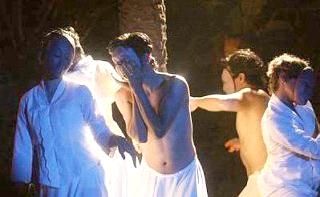CROSSING Borders, part of the Under the Stars Series 2006: Second Flush by Sutra Dance Theatre aimed to challenge definitions as we know them: like, what is traditional and what is modern? What is indigenous and what is foreign?
Performances were held last weekend at Amphi-Sutra in Kuala Lumpur. The evening began with Christopher Yohmei rendering Ichijo (The Immutable, composed by Seiho Kineya in 1975) on a shakuhachi (Japanese bamboo flute). Yohmei looked like a saxophone player, from the way he held the vertical instrument to the way he carried himself. But what he played was no typical jazz piece. The tune he rendered was distinctly Japanese. For several minutes, I enjoyed the haunting, gentle and mellow music. But after a while, boredom set in.
Traditional Japanese music played on the shakuhachi, just like the Chinese bamboo flute, can be manipulated to reflect the many sounds of nature – trickling rain, rustling leaves, birds chirping, the sound of horses galloping on a wide plain, and so forth. No doubt nature is a wonder in itself, but listening to this piece, I felt as if I was watching a plant grow.
Unfortunately, his next piece, Hienso (The Transitory) was no different. The “I-can-grow-old-listening-to-this” was reflected in the dance interpreted and performed by Ramli Ibrahim and Guna. They tried to show the concept of amica (impermanence) – meaning all things would eventually fade and die.
Ramli appeared as half-elf, half-shaman, flitting on stage with a stem. It was difficult to identify him as a delicate, blossoming flower – the image he was trying to portray. Ironically, the younger Guna appeared as the (artificially-greyed) old man bent with burden as Ramli left the staged. The interpretation of Hienso was all too literal.
I was stricken by Starstruck, choreographed by Rathimalar Govindarajoo. She attempted to cross borders by incorporating the kinetic energy of Bharatanatyam and martial arts, while informed by contemporary twists and sensibilities. However, “crossing borders” requires more refined and subtle treatment. I shifted uncomfortably in my chair as I watched the choreographer force different forms of art and ideas into her work, in invasive and intrusive ways.
A party comprising S. Felix (on the sitar), Jaya Sekhar (veena), Ravin Sikander (tabla) and Theban Arumugam (mirdangam and ganjira) provided musical relief with jughalbandhi, a blend of northern and southern Indian music which evolved 50 years ago.
They “crossed borders” by sharing one tune, rag keeravani (a melodic mode in Southern Indian music), and one type of rhythm – a 16-beat cycle (called peen paal in the north and eka paal, the south). It was sheer pleasure listening to Felix and Sekhar (the main artists) improvise on their respective instruments. Accents at different places gave delightful bursts of detail when one least expected it. The performance had my feet tapping throughout.
Next, a qawalli (devotional music of the sufis, performed throughout India and Pakistan) entitled Yadaan Bichde (Memories), which focuses on the theme of love was presented. Principal vocalist Haider Ali (who studied music under the Qawal family of the late Ustad Selamat Ali Khan), supported by vocalists Shah Rukh and Shabeer Ahmed, sung about how memories of a lover could pierce the heart. They then begged God to banish this pain of separation.
The style of singing was close to theatrical. The vocalists seemed to be having a conversation with each other and their animated expressions certainly looked it! At some point, I thought the singing was too loud and piercing, but I was told it was supposed to be that way.
Finally, all the musicians came together to present an improvisation on the rag gunkali, a melodic mode in Northern Indian music. In the improvisation, the Japanese shakuhuchi combined with qawali vocals and Indian instruments (veena, sitar, table and mirdangam) to create a cross-cultural and cross-musical experience.
The Hindustani rag shares almost the same melodic mode as the traditional Japanese miyako bushi scale (one of the scales used in Japanese art music). In this piece, the shakuhachi took the place of the bansuri (side-blown Indian flute) while maintaining its tonal characteristics.
Together, the musicians returned to the thematic melody to punctuate the improvisations while keeping to their own styles. They also collaborated with Sutra to present the highlight of the evening, a sneak preview of Navarasa (nine rasa) conceptualised by Ramli and Guna.
 Navarasa (pix source - The Star)
Navarasa (pix source - The Star)The pair, together with seven other dancers, emerged masked. Their “frozen” faces were a direct contradiction of what the piece intended to portray – the nine human sentiments, that is, love, valour, compassion, wonderment, mirth/laughter, terror, disgust, anger and serenity. Even after the masks were removed, the faces were slow to melt into the sentiments. But, to be fair, the snippet we saw of the full-length Navarasa was too short to draw out the full potential of the choreography.
No comments:
Post a Comment